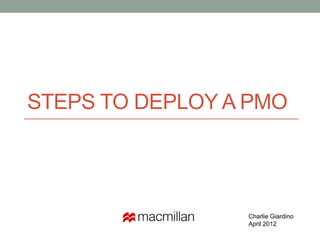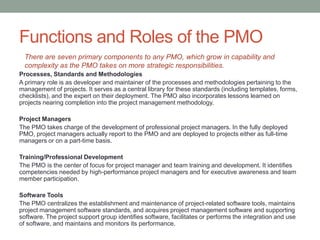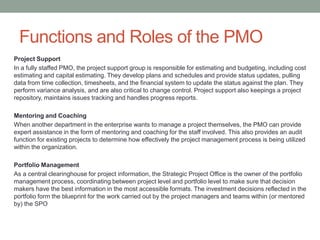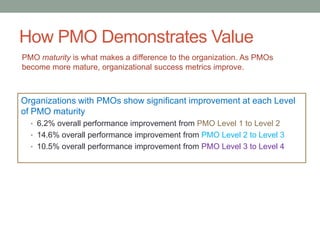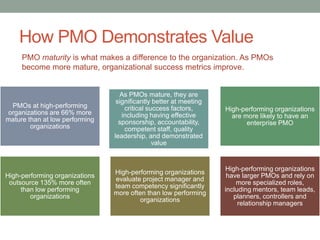Steps to deploy a pmo
- 1. STEPS TO DEPLOY A PMO Charlie Giardino April 2012
- 2. What is a PMO? A PMO is an âofficeâ â either physical or virtual â staffed by project management professionals who serve their organizationâs project management needs. It serves as an organizational center for project management excellence.
- 3. Where does the PMO exist? The PMO may exist in one of three levels: Level 1: The project control office A Level 1 PMO typically manages large, complex single projects that often require multiple schedules that need to be integrated into an overall program schedule. Level 2: Business unit project management office A Level 2 PMO integrates multiple projects of varying sizes within a business unit from small, short-term initiatives to multi-month or multi-year initiatives that require dozens of resources and complex integration of technologies. Level 3: Enterprise project management office A Level 3 PMO serves as a repository for the standards, processes, and methodologies that improve project performance across the enterprise. It also serves to mitigate conflicts in the competition for resources. It allows the organization to manage its entire collection of projects as one or more interrelated portfolios so executive management can get the big picture of all project activity across the enterprise from a central source. A Level 3 PMO infuses a project management culture throughout the organization
- 4. Steps to Deploy a PMO Assess the current state Establish short- and long-term objectives Move forward with some rapid successes
- 5. Assess the Current State âĒ What is the maturity of your program/project management practices? âĒ Of strategy management practices? âĒ Are there qualified personnel in house to carry out the implementation, or will you need outside assistance? âĒ What cultural barriers will need to be overcome? Remember, deploying a PMO is an investment and a project â it should be subjected to the same planning, risk identification, and benefits analysis as everything else in your portfolio
- 6. Objectives âĒ A short-term objective might be to inventory all projects. âĒ A long-term objective might be to integrate cost and resource management across the enterprise.
- 7. Immediate Successes This will do more than anything to sway the organizational culture toward the new way of doing business. Recovering troubled initiatives Training project teams Eliminating duplication of effort via the portfolio inventory
- 8. Functions and Roles of the PMO There are seven primary components to any PMO, which grow in capability and complexity as the PMO takes on more strategic responsibilities. Processes, Standards and Methodologies A primary role is as developer and maintainer of the processes and methodologies pertaining to the management of projects. It serves as a central library for these standards (including templates, forms, checklists), and the expert on their deployment. The PMO also incorporates lessons learned on projects nearing completion into the project management methodology. Project Managers The PMO takes charge of the development of professional project managers. In the fully deployed PMO, project managers actually report to the PMO and are deployed to projects either as full-time managers or on a part-time basis. Training/Professional Development The PMO is the center of focus for project manager and team training and development. It identifies competencies needed by high-performance project managers and for executive awareness and team member participation. Software Tools The PMO centralizes the establishment and maintenance of project-related software tools, maintains project management software standards, and acquires project management software and supporting software. The project support group identifies software, facilitates or performs the integration and use of software, and maintains and monitors its performance.
- 9. Functions and Roles of the PMO Project Support In a fully staffed PMO, the project support group is responsible for estimating and budgeting, including cost estimating and capital estimating. They develop plans and schedules and provide status updates, pulling data from time collection, timesheets, and the financial system to update the status against the plan. They perform variance analysis, and are also critical to change control. Project support also keepings a project repository, maintains issues tracking and handles progress reports. Mentoring and Coaching When another department in the enterprise wants to manage a project themselves, the PMO can provide expert assistance in the form of mentoring and coaching for the staff involved. This also provides an audit function for existing projects to determine how effectively the project management process is being utilized within the organization. Portfolio Management As a central clearinghouse for project information, the Strategic Project Office is the owner of the portfolio management process, coordinating between project level and portfolio level to make sure that decision makers have the best information in the most accessible formats. The investment decisions reflected in the portfolio form the blueprint for the work carried out by the project managers and teams within (or mentored by) the SPO
- 10. How PMO Demonstrates Value PMO maturity is what makes a difference to the organization. As PMOs become more mature, organizational success metrics improve. Organizations with PMOs show significant improvement at each Level of PMO maturity âĒ 6.2% overall performance improvement from PMO Level 1 to Level 2 âĒ 14.6% overall performance improvement from PMO Level 2 to Level 3 âĒ 10.5% overall performance improvement from PMO Level 3 to Level 4
- 11. How PMO Demonstrates Value PMO maturity is what makes a difference to the organization. As PMOs become more mature, organizational success metrics improve. As PMOs mature, they are significantly better at meeting PMOs at high-performing critical success factors, High-performing organizations organizations are 66% more including having effective are more likely to have an mature than at low performing sponsorship, accountability, enterprise PMO organizations competent staff, quality leadership, and demonstrated value High-performing organizations High-performing organizations High-performing organizations have larger PMOs and rely on evaluate project manager and outsource 135% more often more specialized roles, team competency significantly than low performing including mentors, team leads, more often than low performing organizations planners, controllers and organizations relationship managers

